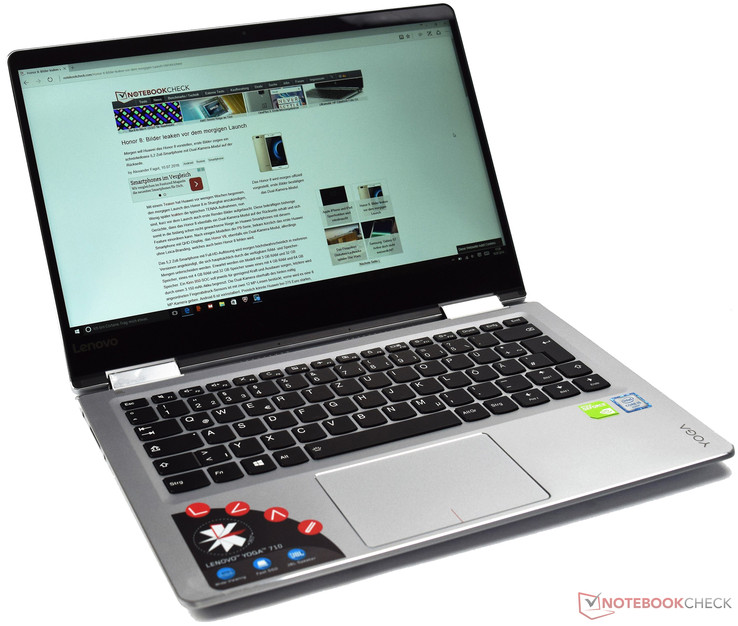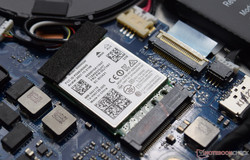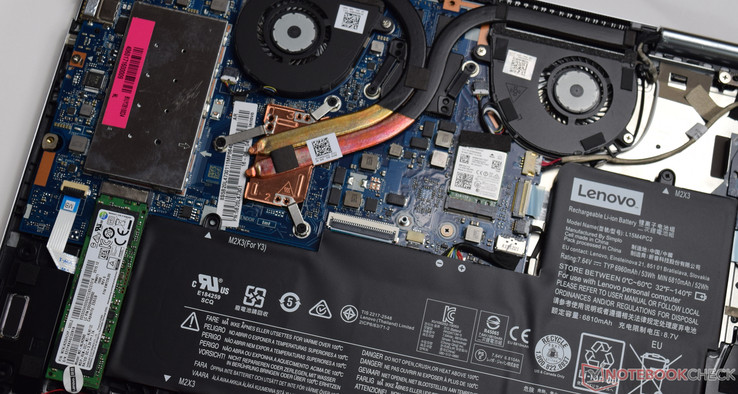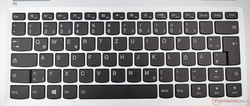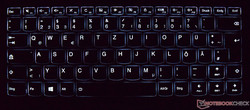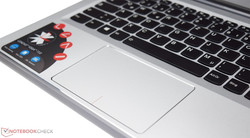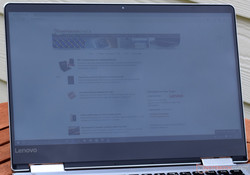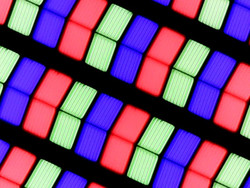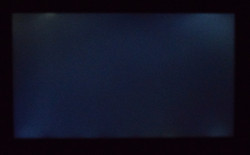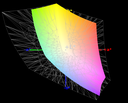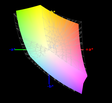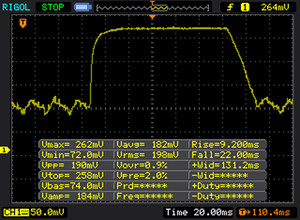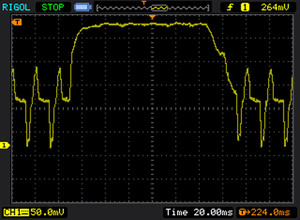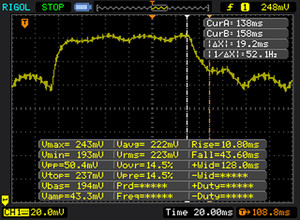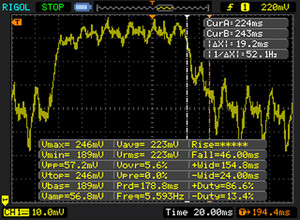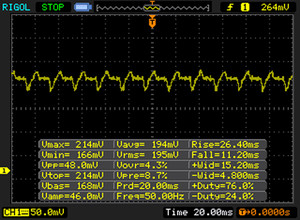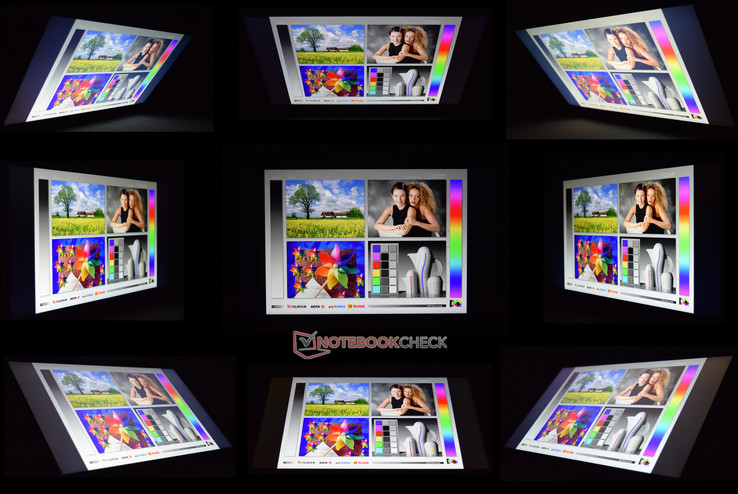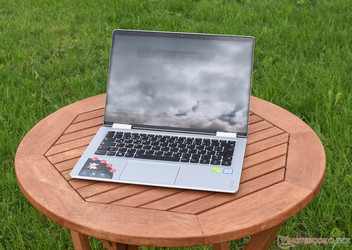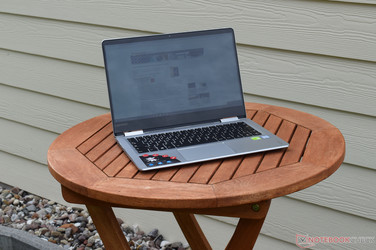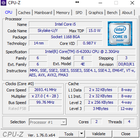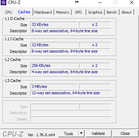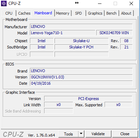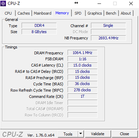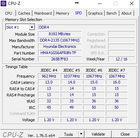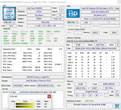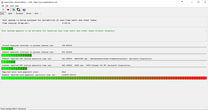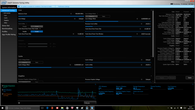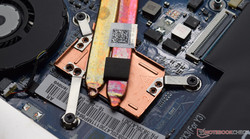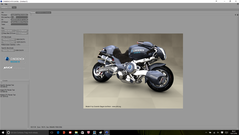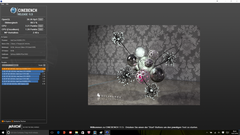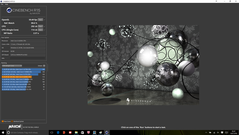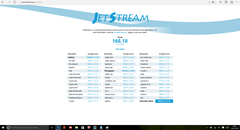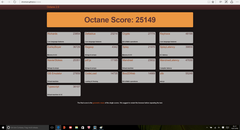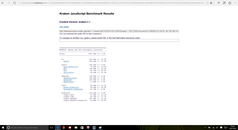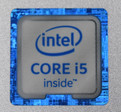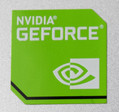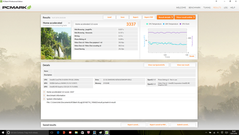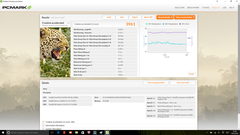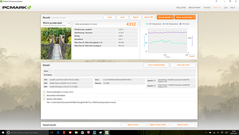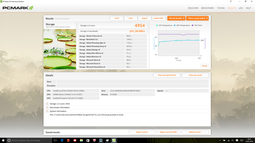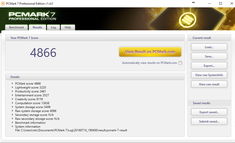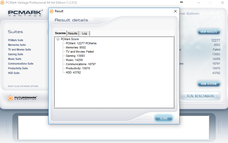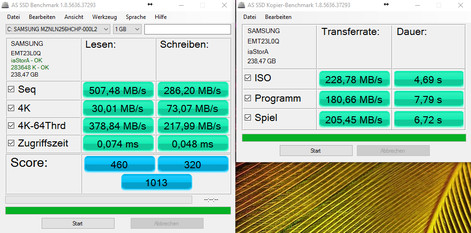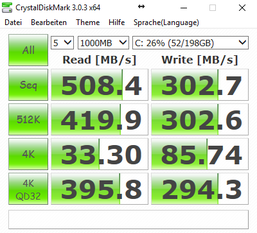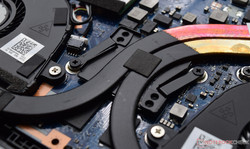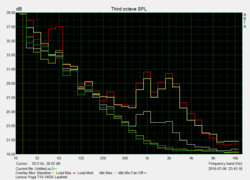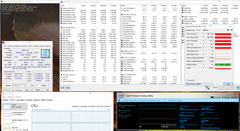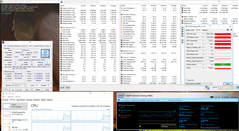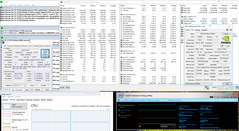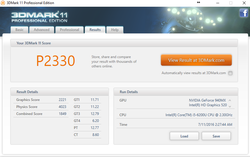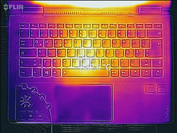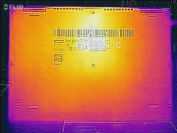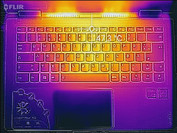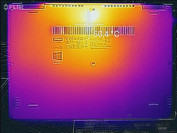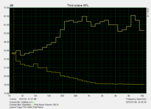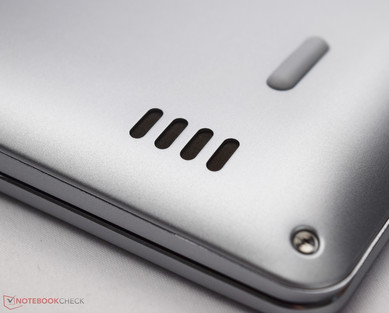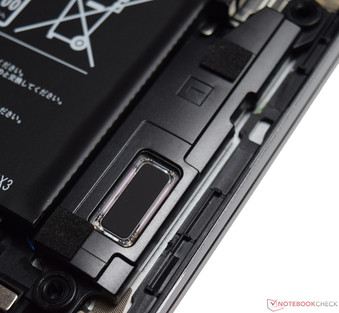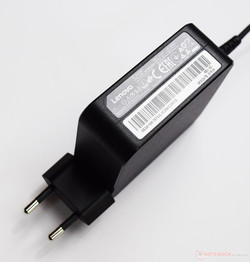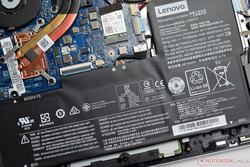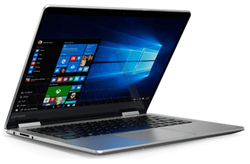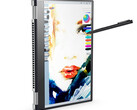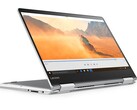Lenovo Yoga 710-14ISK Convertible Review
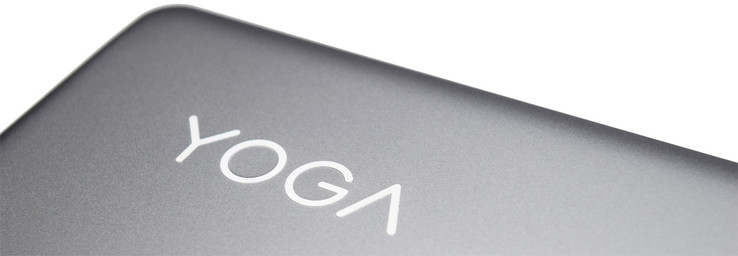
For the original German review, see here.
Lenovo's Yoga series, which is designed for home use, gains another member - the Yoga 710-14ISK. Our review sample is equipped with an Intel Core i5-6200U, 8 GB of DDR4 RAM and a dedicated GPU (Nvidia GeForce 940MX). The OS is installed on a 256 GB M.2 SSD. Lenovo actually offers two different hardware options, which only differ in the choice of the processor - either the Intel Core i5-6200U or the Intel Core i7-6500U. The price difference is 200 Euros (~$225). As configured, our review convertible costs about 1000 Euros (~$1120). The notebook is available in either silver or black. The dedicated Nvidia GeForce 940MX has access to 2 GB of DDR3 RAM. For our review, we decided to compare the test model with other similarly priced convertibles with a dedicated GPU.
Below is a list of the convertibles we will reference during the review:
- Lenovo Yoga 510-15ISK (899 Euros/~$1005)
- Lenovo Yoga 3 14 (1000 Euros/~$1120)
- HP Envy 15-w103ng x360 (999 Euros/~$1120)
Case
The chassis is constructed primarily out of aluminum. Our version of the 710 is silver (Platinum Silver), but black (Ebony Black) is an option as well. Lenovo has selected premium materials for their convertible, which looks quite upscale. The silver surface is not very susceptible to fingerprints, but if needed, the convertible is easy to clean with a moistened cloth. The Yoga's construction is flawless and the transitional gaps are very even. Weighing in at 1.6 kg (~3.5 lb), the review notebook is also quite light when compared to its competitors. Raised "YOGA" lettering adorns the display lid.
The base as well as the display features beveled chrome edges, which enhance the look without looking obnoxious. The system is very sturdy: the base resists pressure and is torsionally very rigid. The same is true of the display lid, which is very resilient thanks to the materials used. Pressure on the back of the lid does not affect the display at all. The 360-degree hinges hold the display in place well; although there is some slight bouncing in laptop mode - but convertibles generally have this issue. One-handed opening is not possible. The bottom does not feature a maintenance cover, so to swap the SSD or clean the fan, the user has to remove the entire bottom cover. This is easily accomplished once all the tiny screws are removed.
Size Comparison
Size-wise, the Yoga 710 is smaller than the competitors - in some cases significantly so. After all: the Yoga has a 14-inch display, whereas the HP Envy 15 and the Lenovo Yoga 510 have 15.6-inch panels. A comparison with the Lenovo Yoga 3 14 (also a 14-inch convertible) shows that the Yoga 710 is smaller still - even if only by a few millimeters. The difference in size correlates with the weight as well and the review convertible - which weights 1.6 kg (~3.5 lb) - is the lightest device in our comparison.
Connectivity
Taking inventory of the number of physical ports does not take very long. The right side houses the two USB 3.0 ports next to a Mini-HDMI port. The opposite side is home to the card reader, which can handle all current formats (MMC, SD, SDHC, and SDXC) as well as the headphone jack. Inserted SD cards stick out about half their length, so it is essential to remove the card during transport to avoid damage.
The Yoga 710 lacks the volume rocker switch, which is normally found on convertibles to be used while in tablet mode. A Kensington lock slot is missing as well and Lenovo does not sell any proprietary accessories, either - those are normally reserved for ThinkPad models.
SD Card Reader
The SD card reader on the side can handle all current formats (MMC, SD, SDHC, and SDXC). To check the performance, we used our reference SD card (Toshiba Exceria Pro SDXC 64 GB UHS-II) and copied 250 jpg files to the system drive. We measured an average transfer rate of 77.8 MB/s, which means that the Yoga 710 outperforms both the Lenovo Yoga 510 and the HP Envy 15. To establish the sequential read performance, we use AS SSD. Here, all convertibles run neck and neck with the Yoga 710 posting a score of 87.1 MB/s. Overall, the performance of the review unit is about average.
| SD Card Reader | |
| average JPG Copy Test (av. of 3 runs) | |
| Lenovo Yoga 710-14ISK | |
| Lenovo Yoga 510-15ISK | |
| HP Envy 15-w103ng x360 | |
| maximum AS SSD Seq Read Test (1GB) | |
| HP Envy 15-w103ng x360 | |
| Lenovo Yoga 710-14ISK | |
| Lenovo Yoga 510-15ISK | |
Communication
For communication with the outside world, Lenovo relies on a Dual-Band AC-8260 module from Intel, which also supports Bluetooth 4.0. The module supports a maximum theoretical transfer rate of 867 Mbit/s (2x 801.11ac).We did not encounter any issues during the review period - the connection remained stable at all times and even larger data transfers worked flawlessly. Lenovo has not integrated the WLAN antennas in the display bezel - as is commonly the case with most notebooks and convertibles - but into the hinge, which covers a larger area and guarantees a stable reception.
| Networking | |
| WiFi Speed Client 1m | |
| WiFi Speed Server 1m |
Security
Hardware security is handled by a Trusted Platform Module 2.0 (TPM). However, Lenovo has not included a Kensington Lock slot. The security software consists of McAfee LiveSafe.
Accessories
Only the small 65-watt power adapter and a short user manual are included in the box. Optional accessories, such as the Yoga mouse, Lenovo 500 2.0 Bluetooth speakers or the Lenovo 500 headphones, can be added to the cart at the time of purchase.
Operating System
Our review notebook comes with Microsoft Windows 10 Home 64-bit preinstalled. Since this is not a business notebook, Windows 10 Professional is not offered.
Maintenance
Even though the Yoga 710 lacks a maintenance cover, it is still quite easy to get to the internal components. After removing the entire bottom base unit cover, the user has access to the SSD, the RAM, the cooling fans, and the battery. The RAM is located underneath a metal shield to protect it further. Expandability is restricted to upgrades, since all slots are occupied.
Warranty
The base warranty in Germany is two years. The warranty can be extended to 3 years with Accidental Damage protection for an extra 140 Euros (~$156).
Input Devices
Keyboard
The chiclet keyboard has been integrated directly into the upper part of the base unit. The individual keys sit tightly, so they do not clatter while typing. There is no dedicated number block, which is not necessarily a disadvantage, since the keys are quite large at 17 x 17 mm (~0.7 x 0.7 in) with about 2 mm (~0.1 in) of space between them. The keyboard appears to be well thought-out and the lettering is easy to read - even the symbols on the smaller F keys do not make the keys look cluttered. The keystroke is slightly softer compared to other convertibles and the keyboard noise is well controlled and not obtrusive. The keyboard does not flex at all while typing. The subtle white backlight - which offers two adjustment levels in addition to off - is particularly pleasing.
Touchpad
The multitouch-capable ClickPad featuring a chrome bezel, is integrated into the base unit and measures 10.5 x 7 cm (~4.1 x 3 in), which is large enough for trouble-free inputs. The touchpad is located below the mid-point of the space bar and thus shifted slightly to the left - the Yoga 3 14, on the other hand, has the touchpad centered. Which design is better is a matter of taste. Visually, the Yoga 710 appears rather cleaner: there's a small line at the bottom of the touchpad which separates left and right. Clicks are clearly audible, but do not sound "cheap". The silver, smooth surface lets fingers glide easily and fingerprints are not as noticeable as those we have encountered in the past from other devices.
Touchscreen
During our time with the notebook we did not encounter any issues with the touchscreen performance. The display supports 10-point inputs and allows the fingers to glide easily. All inputs were recognized directly and translated immediately. The bezel is very narrow and makes good use of the available area.
Display
The Yoga 710 comes equipped with a panel from AU Optronics. The 14-inch AH IPS multitouch-display offers a native resolution of 1920x1080 pixels with a resulting pixel density of 157 dpi. The contrast ratio is 929:1, which is quite decent. The average brightness of 298.3 cd/m² surpasses the brightness of the direct competitors; the brightness distribution is also comparatively good at 88%. The glossy display causes unwanted reflections, which makes using the convertible in brightly-lit environments more cumbersome - despite the high average brightness. There are some issues in darker environments with display bleeding, which is particularly noticeable in the upper left when looking at darker scenes. Display bleeding can vary significantly, so our review convertible cannot necessarily be compared to other Yoga 710s. The panel uses PWM at brightness settings of 50% and below, so sensitive users might experience headaches and other issues after prolonged use.
| |||||||||||||||||||||||||
Brightness Distribution: 88 %
Center on Battery: 325 cd/m²
Contrast: 929:1 (Black: 0.35 cd/m²)
ΔE ColorChecker Calman: 6.2 | ∀{0.5-29.43 Ø4.77}
ΔE Greyscale Calman: 6.32 | ∀{0.09-98 Ø5}
90% sRGB (Argyll 1.6.3 3D)
58% AdobeRGB 1998 (Argyll 1.6.3 3D)
Gamma: 2.3
CCT: 6926 K
| Lenovo Yoga 710-14ISK AU Optronics B140HAN03.0, , 1920x1080, 14" | Lenovo Yoga 510-15ISK BOE HF NV156FHM-N42, , 1920x1080, 15.6" | Lenovo Yoga 3 14-80JH0035GE LG Philips LGD047A (LP140WF3-SPL2), , 1920x1080, 14" | HP Envy 15-w103ng x360 LG Philips, , 1920x1080, 15.6" | |
|---|---|---|---|---|
| Display | ||||
| Display P3 Coverage (%) | 42.58 | 39.31 | 39.97 | |
| sRGB Coverage (%) | 63.9 | 58.8 | 59.8 | |
| AdobeRGB 1998 Coverage (%) | 43.99 | 40.65 | 41.32 | |
| Response Times | -11% | 2% | ||
| Response Time Grey 50% / Grey 80% * (ms) | 35 ? | 43.2 ? -23% | 37 ? -6% | |
| Response Time Black / White * (ms) | 31 ? | 30.8 ? 1% | 28 ? 10% | |
| PWM Frequency (Hz) | 50 ? | |||
| Screen | 2% | -2% | -18% | |
| Brightness middle (cd/m²) | 325 | 254 -22% | 239 -26% | 208 -36% |
| Brightness (cd/m²) | 298 | 230 -23% | 227 -24% | 205 -31% |
| Brightness Distribution (%) | 88 | 86 -2% | 88 0% | 80 -9% |
| Black Level * (cd/m²) | 0.35 | 0.26 26% | 0.21 40% | 0.26 26% |
| Contrast (:1) | 929 | 977 5% | 1138 22% | 800 -14% |
| Colorchecker dE 2000 * | 6.2 | 4.23 32% | 5.4 13% | 6.97 -12% |
| Colorchecker dE 2000 max. * | 10.82 | 9.5 12% | ||
| Greyscale dE 2000 * | 6.32 | 2.87 55% | 4.71 25% | 7.37 -17% |
| Gamma | 2.3 96% | 2.35 94% | 2.51 88% | 2.34 94% |
| CCT | 6926 94% | 5965 109% | 6354 102% | 6823 95% |
| Color Space (Percent of AdobeRGB 1998) (%) | 58 | 40.35 -30% | 37 -36% | 38 -34% |
| Color Space (Percent of sRGB) (%) | 90 | 63.48 -29% | 59 -34% | 59 -34% |
| Total Average (Program / Settings) | -5% /
0% | -2% /
-2% | -8% /
-14% |
* ... smaller is better
The overall picture quality is quite good. We measured a black value is 0.35 cd/m²; screen content looks very nice and the colors are vibrant. Although the display is very vivid, the colors are not overpowering. As shipped, the accuracy is about average with an average DeltaE value of 6.2 (goal is less than 3). A calibration improves the color accuracy - we have linked the corresponding ICC profile in the graphic above. The IPS panel does not suffer from a bluish hue and covers the professional color spaces AdobeRGB and sRGB at 58 and 90%, respectively.
Display Response Times
| ↔ Response Time Black to White | ||
|---|---|---|
| 31 ms ... rise ↗ and fall ↘ combined | ↗ 9 ms rise | |
| ↘ 22 ms fall | ||
| The screen shows slow response rates in our tests and will be unsatisfactory for gamers. In comparison, all tested devices range from 0.1 (minimum) to 240 (maximum) ms. » 83 % of all devices are better. This means that the measured response time is worse than the average of all tested devices (20.2 ms). | ||
| ↔ Response Time 50% Grey to 80% Grey | ||
| 35 ms ... rise ↗ and fall ↘ combined | ↗ 16 ms rise | |
| ↘ 19 ms fall | ||
| The screen shows slow response rates in our tests and will be unsatisfactory for gamers. In comparison, all tested devices range from 0.165 (minimum) to 636 (maximum) ms. » 47 % of all devices are better. This means that the measured response time is worse than the average of all tested devices (31.6 ms). | ||
Screen Flickering / PWM (Pulse-Width Modulation)
| Screen flickering / PWM detected | 50 Hz | ≤ 50 % brightness setting | |
The display backlight flickers at 50 Hz (worst case, e.g., utilizing PWM) Flickering detected at a brightness setting of 50 % and below. There should be no flickering or PWM above this brightness setting. The frequency of 50 Hz is very low, so the flickering may cause eyestrain and headaches after extended use. In comparison: 53 % of all tested devices do not use PWM to dim the display. If PWM was detected, an average of 8084 (minimum: 5 - maximum: 343500) Hz was measured. | |||
Since the Yoga 710 offers more than one display mode, the viewing angle stability is very important - and the IPS display does not disappoint. Screen content is readable from nearly all positions without noticeable deterioration. Outdoor use is hampered though, because of the glossy and thus reflective panel. We recommend working in the shade whenever possible.
Performance
The performance is very decent for a convertible and even suitable for moderate gaming thanks to the dedicated GPU. The 14-inch IPS display is also large enough for the occasional movie. The Skylake-generation Intel Core i5-6200U offers enough performance for most tasks. The 8 GB of DDR4 RAM operates in single-channel mode - since the Yoga only has one RAM slot, dual-channel is not supported. The SSD is of the M.2 2280 variety and very fast. For 3D applications, the notebook makes use of the dedicated Nvidia GeForce 940MX with 2 GB of DDR3 RAM.
At the time of the review, the only available CPU options are the Intel Core i5-6200U or the Intel Core i7-6500U. Our review notebook is equipped with the slower processor and sells for 1000 Euros (~$1120). The slightly faster model sells for 200 more Euros and costs 1200 Euros (~$1340).
Processor
The Intel Core i5-6200U is more than fast enough for a convertible. The frugal dual-core unit can - thanks to Hyperthreading - process 4 threads in parallel and has a TDP of only 15 watts. Thanks to the low power consumption, the CPU is a good choice for mobile devices which frequently need to operate away from outlets. The base clock speed is 2.3 GHz; the Turbo can overclock a single core to 2.8 GHz and both cores to 2.7 GHz. The performance is comparable to other notebooks equipped with Skylake-generation CPUs. Only the Lenovo Yoga 3 14, which is equipped with the predecessor Intel Core i5-5200U, cannot quite offer the same performance as the Intel Core i5-6200U and is about 10% slower depending on the application. The Yoga with the Intel Core i7-6500U, on the other hand, is about 10% faster than the review convertible. It is up to the user to decide if the added cost for the i7 model is worth it.
| Cinebench R10 | |
| Rendering Single CPUs 64Bit (sort by value) | |
| Lenovo Yoga 710-14ISK | |
| Lenovo Yoga 3 14-80JH0035GE | |
| Rendering Multiple CPUs 64Bit (sort by value) | |
| Lenovo Yoga 710-14ISK | |
| Lenovo Yoga 3 14-80JH0035GE | |
| JetStream 1.1 - Total Score (sort by value) | |
| Lenovo Yoga 710-14ISK | |
| Lenovo Yoga 510-15ISK | |
| HP Envy 15-w103ng x360 | |
| Octane V2 - Total Score (sort by value) | |
| Lenovo Yoga 710-14ISK | |
| Lenovo Yoga 510-15ISK | |
| Lenovo Yoga 3 14-80JH0035GE | |
| HP Envy 15-w103ng x360 | |
| Mozilla Kraken 1.1 - Total (sort by value) | |
| Lenovo Yoga 710-14ISK | |
| Lenovo Yoga 510-15ISK | |
| Lenovo Yoga 3 14-80JH0035GE | |
| HP Envy 15-w103ng x360 | |
* ... smaller is better
System Performance
Perceived performance is very good. Thanks to the fast SSD, the system boots quickly within a few seconds. According to the PCMark 8 benchmark tests, the Yoga 710 comes in second place to the Lenovo Yoga 510-15ISK. The performance difference is roughly 10%. The fast M.2 2280 SSD contributes significantly to the overall responsiveness. During use, we did not notice any latency when opening applications. 8 GB of RAM is quite generous, so there are no bottlenecks here during normal use.
| PCMark 8 | |
| Home Score Accelerated v2 (sort by value) | |
| Lenovo Yoga 710-14ISK | |
| Lenovo Yoga 510-15ISK | |
| Lenovo Yoga 3 14-80JH0035GE | |
| HP Envy 15-w103ng x360 | |
| Creative Score Accelerated v2 (sort by value) | |
| Lenovo Yoga 710-14ISK | |
| Lenovo Yoga 510-15ISK | |
| Lenovo Yoga 3 14-80JH0035GE | |
| HP Envy 15-w103ng x360 | |
| Work Score Accelerated v2 (sort by value) | |
| Lenovo Yoga 710-14ISK | |
| Lenovo Yoga 510-15ISK | |
| Lenovo Yoga 3 14-80JH0035GE | |
| HP Envy 15-w103ng x360 | |
| PCMark 7 | |
| Score (sort by value) | |
| Lenovo Yoga 710-14ISK | |
| Lenovo Yoga 510-15ISK | |
| Lenovo Yoga 3 14-80JH0035GE | |
| Productivity (sort by value) | |
| Lenovo Yoga 710-14ISK | |
| Lenovo Yoga 510-15ISK | |
| PCMark Vantage Result | 12277 points | |
| PCMark 7 Score | 4866 points | |
| PCMark 8 Home Score Accelerated v2 | 3337 points | |
| PCMark 8 Creative Score Accelerated v2 | 3961 points | |
| PCMark 8 Work Score Accelerated v2 | 4312 points | |
Help | ||
Storage Devices
The Lenovo Yoga 710 comes equipped with a 256 GB M.2 2280 SSD from Samsung. According to the manufacturer, the drive should be capable of 540 MB/s reads and up to 280 MB/s writes. According to our test with the tool AS SSD, the SSD topped out at 507 MB/s (reads) and 286 MB/s (writes). This means that in this implementation, the M.2 drive operates close to the possible maximum. There is no slot for an additional drive, so the only option to increase the available storage space is to swap out the drive for a larger one.
| Lenovo Yoga 710-14ISK Samsung SSD PM871 MZNLN256HCHP | Lenovo Yoga 510-15ISK Liteonit CV3-DE256 | Lenovo Yoga 3 14-80JH0035GE Samsung SSD PM851 256 GB MZYTE256HMHP | HP Envy 15-w103ng x360 Samsung SSD PM851 256 GB MZNTE256HMHP | |
|---|---|---|---|---|
| CrystalDiskMark 3.0 | -5% | -2% | -10% | |
| Read Seq (MB/s) | 508 | 487 -4% | 525 3% | 515 1% |
| Write Seq (MB/s) | 302.7 | 450.7 49% | 265.8 -12% | 240.7 -20% |
| Read 512 (MB/s) | 419.9 | 384.5 -8% | 428.9 2% | 391.3 -7% |
| Write 512 (MB/s) | 302.6 | 356.3 18% | 266.1 -12% | 240 -21% |
| Read 4k (MB/s) | 33.3 | 27.05 -19% | 35.18 6% | 27.64 -17% |
| Write 4k (MB/s) | 85.8 | 63.7 -26% | 97.6 14% | 95.2 11% |
| Read 4k QD32 (MB/s) | 395.8 | 281.5 -29% | 354.6 -10% | 367.9 -7% |
| Write 4k QD32 (MB/s) | 294.3 | 232 -21% | 265.4 -10% | 239 -19% |
GPU Performance
The Yoga 710 comes with a dedicated Nvidia GeForce 940MX GPU, which was introduced in March as a refresh of the Nvidia GeForce 940M. The updated graphics card now also supports DirectX 12. Depending on the use, the maximum power consumption is anywhere between 15 and 30 watts at speeds between 1122 and 1242 MHz. Our version has access to 2 GB of DDR3 RAM. Nvidia does not offer any GeForce 940MX models with GDDR5 RAM. On paper, the performance of the Nvidia GeForce 940MX is comparable to the Nvidia GeForce 940M - the results of the 3DMark benchmark tests confirm this.
For less intensive graphics tasks, the system relies on the Intel HD Graphics 520. Graphics switching happens automatically and is completely transparent to the user. The Intel HD Graphics 520 is integrated into the CPU and supports the processor when running 2D applications. In addition, the integrated graphics card supports DirectX 12 just like the dedicated GPU and offers support for modern H.265/HEVC codecs as well.
| 3DMark | |
| 1280x720 Cloud Gate Standard Graphics | |
| Lenovo Yoga 710-14ISK | |
| Lenovo Yoga 3 14-80JH0035GE | |
| HP Envy 15-w103ng x360 | |
| Lenovo Yoga 510-15ISK | |
| 1920x1080 Fire Strike Graphics | |
| Lenovo Yoga 3 14-80JH0035GE | |
| Lenovo Yoga 710-14ISK | |
| HP Envy 15-w103ng x360 | |
| Lenovo Yoga 510-15ISK | |
| 1280x720 Ice Storm Standard Graphics | |
| HP Envy 15-w103ng x360 | |
| Lenovo Yoga 510-15ISK | |
| Lenovo Yoga 710-14ISK | |
| Lenovo Yoga 3 14-80JH0035GE | |
| 3DMark 11 | |
| 1280x720 Performance | |
| Lenovo Yoga 710-14ISK | |
| Lenovo Yoga 3 14-80JH0035GE | |
| HP Envy 15-w103ng x360 | |
| Lenovo Yoga 510-15ISK | |
| 1280x720 Performance GPU | |
| Lenovo Yoga 710-14ISK | |
| Lenovo Yoga 3 14-80JH0035GE | |
| HP Envy 15-w103ng x360 | |
| Lenovo Yoga 510-15ISK | |
| 3DMark 06 - 1280x1024 Standard Score AA:0x AF:0x | |
| Lenovo Yoga 710-14ISK | |
| Lenovo Yoga 510-15ISK | |
| 3DMark 03 Standard | 26745 points | |
| 3DMark 05 Standard | 19024 points | |
| 3DMark 06 Standard Score | 11658 points | |
| 3DMark Vantage P Result | 7479 points | |
| 3DMark 11 Performance | 2330 points | |
| 3DMark Ice Storm Standard Score | 42965 points | |
| 3DMark Cloud Gate Standard Score | 6168 points | |
| 3DMark Fire Strike Score | 1365 points | |
| 3DMark Fire Strike Extreme Score | 690 points | |
Help | ||
Gaming Performance
With its dedicated GPU, the Yoga 710 supports gaming - at least to some degree. The performance is not unlimited and often is only enough for HD resolution and the medium preset. Games released in 2015 and 2016 generally are not playable without noticeable stuttering - but considering this convertible functions as a tablet as well, this is not unexpected. Users who yearn for better gaming performance should consider a notebook equipped with an Nvidia GeForce GTX 960M instead.
| low | med. | high | ultra | |
|---|---|---|---|---|
| Dirt 3 (2011) | 60.3 | 55.7 | 40.7 | 16.3 |
| Hitman: Absolution (2012) | 54.9 | 35.7 | 25.1 | 13.4 |
| BioShock Infinite (2013) | 85.3 | 47.7 | 39.5 | 13.6 |
| GRID 2 (2013) | 121.5 | 80.4 | 56.3 | 19.6 |
| Battlefield 4 (2013) | 66.5 | 43.2 | 28.6 | 10.4 |
| Thief (2014) | 31.3 | 23 | 18.5 | 9.1 |
| Titanfall (2014) | 60 | 49.2 | 40.1 | 23.6 |
| The Elder Scrolls Online (2014) | 79.6 | 77.4 | 58.3 | 31.4 |
| GRID: Autosport (2014) | 137 | 70.9 | 21.8 | 15.7 |
| Risen 3: Titan Lords (2014) | 50.7 | 36.8 | 11.2 | 7.8 |
| Fifa 15 (2014) | 96.3 | 72.7 | 47.9 | |
| Ryse: Son of Rome (2014) | 24.5 | 18.7 | 8.9 | 8.4 |
| The Evil Within (2014) | 39.2 | 27.9 | 16.7 | |
| F1 2014 (2014) | 99 | 85 | 48 | 29 |
| Civilization: Beyond Earth (2014) | 67.2 | 29.7 | 21.4 | 17.3 |
| Call of Duty: Advanced Warfare (2014) | 50.4 | 30.4 | 13 | 12.1 |
| Assassin's Creed Unity (2014) | 29.4 | 17.9 | 12.1 | 8.3 |
| Far Cry 4 (2014) | 44.2 | 31.4 | 14.2 | 13.3 |
| The Crew (2014) | 43.4 | 36.7 | 17.2 | 9.8 |
| The Witcher 3 (2015) | 23.8 | 16 | 8.5 | 5.4 |
| Batman: Arkham Knight (2015) | 28 | 24 | 10 | 10 |
| Rise of the Tomb Raider (2016) | 27.4 | 17.7 | 10.4 | 8.2 |
Emissions
System Noise
The Yoga 710 is equipped with two heatpipes which are cooled by two small fans. Even without load, the fans rarely stop spinning completely, which results in a noise level of 34.6 dB(A) while idling. Under full load - simulated with Prime95 and FurMark - we measured a maximum of 39.9 dB(A). These results slightly surpass those of other notebooks. However, while the two fans are audible, they are not obtrusive in any way.
Noise level
| Idle |
| 32.5 / 34.6 / 34.6 dB(A) |
| Load |
| 38.7 / 39.9 dB(A) |
 | ||
30 dB silent 40 dB(A) audible 50 dB(A) loud |
||
min: | ||
| Lenovo Yoga 710-14ISK Intel Core i5-6200U, GeForce 940MX | Lenovo Yoga 510-15ISK Intel Core i5-6200U, Radeon R7 M460 | Lenovo Yoga 3 14-80JH0035GE Intel Core i5-5200U, GeForce 940M | HP Envy 15-w103ng x360 Intel Core i5-6200U, GeForce 930M | |
|---|---|---|---|---|
| Noise | 10% | 1% | -0% | |
| off / environment * (dB) | 32.2 | 29 10% | ||
| Idle Minimum * (dB) | 32.5 | 29 11% | 32 2% | 32.9 -1% |
| Idle Average * (dB) | 34.6 | 29 16% | 32.6 6% | 32.9 5% |
| Idle Maximum * (dB) | 34.6 | 29 16% | 33.9 2% | 32.9 5% |
| Load Average * (dB) | 38.7 | 35.9 7% | 40.1 -4% | 37 4% |
| Load Maximum * (dB) | 39.9 | 41 -3% | 39.8 -0% | 46 -15% |
* ... smaller is better
Temperature
With a recorded temperature of 27 °C (~81 °F) while idling, the chassis remains under 30 °C (~86 °F) in all areas. Under load, the temperature increases to a maximum of 43.4 °C (~110 °F). The hot spots are located on the top in the middle and above the keyboard. During the stress test - which simulates extreme conditions commonly not encountered during normal use - Prime95 and FurMark run in parallel for at least one hour. The CPU tops out at 82 °C ~180 °F) and the GPU at 74°C (~165 °). The processor operates at a constant 2.3 GHz. The Nvidia GeForce 940MX fluctuates minimally between 980 MHz and 1050 MHz. Thermal throttling was not an issue at any time. A repeat of the 3DMark 11 benchmark right after the stress test ended with a score almost identical to the one we recorded after a cold start. In other words: there is no loss of power even when the system operates under full load for prolonged periods of time.
(±) The maximum temperature on the upper side is 43.4 °C / 110 F, compared to the average of 35.4 °C / 96 F, ranging from 19.6 to 60 °C for the class Convertible.
(±) The bottom heats up to a maximum of 43.2 °C / 110 F, compared to the average of 36.8 °C / 98 F
(+) In idle usage, the average temperature for the upper side is 26.7 °C / 80 F, compared to the device average of 30.3 °C / 87 F.
(+) The palmrests and touchpad are reaching skin temperature as a maximum (32 °C / 89.6 F) and are therefore not hot.
(-) The average temperature of the palmrest area of similar devices was 27.9 °C / 82.2 F (-4.1 °C / -7.4 F).
Speakers
The Yoga 710 is equipped with two small stereo speakers from JBL located towards the front on the underside of the base unit. Placing the convertible on a soft surface in laptop mode results in a somewhat muffled sound. Users who want the best sound quality need to ensure that the small openings for the speakers are not covered. The sound quality is good overall with mids and high dominating and bass just audible. Of course, external speakers or good headphones are much superior, so we recommend them for the best experience. The Dolby Audio software allows the user to adjust the sound to his or her liking.
Lenovo Yoga 710-14ISK audio analysis
(-) | not very loud speakers (67 dB)
Bass 100 - 315 Hz
(±) | reduced bass - on average 9.5% lower than median
(±) | linearity of bass is average (8.2% delta to prev. frequency)
Mids 400 - 2000 Hz
(+) | balanced mids - only 2.4% away from median
(+) | mids are linear (5% delta to prev. frequency)
Highs 2 - 16 kHz
(+) | balanced highs - only 2.7% away from median
(±) | linearity of highs is average (7.1% delta to prev. frequency)
Overall 100 - 16.000 Hz
(+) | overall sound is linear (13.8% difference to median)
Compared to same class
» 19% of all tested devices in this class were better, 4% similar, 77% worse
» The best had a delta of 6%, average was 20%, worst was 57%
Compared to all devices tested
» 15% of all tested devices were better, 4% similar, 81% worse
» The best had a delta of 4%, average was 24%, worst was 134%
Apple MacBook 12 (Early 2016) 1.1 GHz audio analysis
(+) | speakers can play relatively loud (83.6 dB)
Bass 100 - 315 Hz
(±) | reduced bass - on average 11.3% lower than median
(±) | linearity of bass is average (14.2% delta to prev. frequency)
Mids 400 - 2000 Hz
(+) | balanced mids - only 2.4% away from median
(+) | mids are linear (5.5% delta to prev. frequency)
Highs 2 - 16 kHz
(+) | balanced highs - only 2% away from median
(+) | highs are linear (4.5% delta to prev. frequency)
Overall 100 - 16.000 Hz
(+) | overall sound is linear (10.2% difference to median)
Compared to same class
» 7% of all tested devices in this class were better, 2% similar, 91% worse
» The best had a delta of 5%, average was 18%, worst was 53%
Compared to all devices tested
» 4% of all tested devices were better, 1% similar, 94% worse
» The best had a delta of 4%, average was 24%, worst was 134%
Frequency diagram comparison (click the checkboxes)
Value 1: Pink Noise 100% Vol.; Value 2: Audio turned off
Energy Management
Power Consumption
The power consumption of the 14-inch Yoga is quite high compared to the other three comparison convertibles. While idling, we measure an average power consumption of 9.4 watts - the Lenovo Yoga 3 14 only requires 5.5 watts. Under load, the power draw increased to a maximum of 47.2 watts. Once again, the Lenovo Yoga 3 14 needs much less at 40.4 watts. The power adapter is rated for 65 watts - enough to charge the convertible even under full load.
| Off / Standby | |
| Idle | |
| Load |
|
Key:
min: | |
| Lenovo Yoga 710-14ISK 6200U, GeForce 940MX, Samsung SSD PM871 MZNLN256HCHP, a-Si WLED TFT, IPS, 1920x1080, 14" | Lenovo Yoga 510-15ISK 6200U, Radeon R7 M460, Liteonit CV3-DE256, IPS, 1920x1080, 15.6" | Lenovo Yoga 3 14-80JH0035GE 5200U, GeForce 940M, Samsung SSD PM851 256 GB MZYTE256HMHP, IPS, 1920x1080, 14" | HP Envy 15-w103ng x360 6200U, GeForce 930M, Samsung SSD PM851 256 GB MZNTE256HMHP, IPS, 1920x1080, 15.6" | |
|---|---|---|---|---|
| Power Consumption | 10% | 28% | 15% | |
| Idle Minimum * (Watt) | 4.9 | 4 18% | 3.2 35% | 4.15 15% |
| Idle Average * (Watt) | 9.4 | 7.5 20% | 5.5 41% | 8.2 13% |
| Idle Maximum * (Watt) | 10.7 | 8.1 24% | 6.8 36% | 8.2 23% |
| Load Average * (Watt) | 46 | 40.8 11% | 40 13% | 34.6 25% |
| Load Maximum * (Watt) | 47.2 | 57.3 -21% | 40.4 14% | 48 -2% |
* ... smaller is better
Battery Life
The battery life of the Yoga 710 surpasses that of the competition. Part of the reason for the better performance is the higher-capacity battery with 53 Wh. Under full load, the Yoga lasts for 2 hours 27 minutes before shutting down. We recorded a run time of 7 hours 13 minutes during our WLAN test, which closely simulates the real-life battery usage. The run times are quite good and with moderate use, the convertible will easily last an entire work day.
| Lenovo Yoga 710-14ISK 6200U, GeForce 940MX, 53 Wh | Lenovo Yoga 510-15ISK 6200U, Radeon R7 M460, 35 Wh | Lenovo Yoga 3 14-80JH0035GE 5200U, GeForce 940M, 47 Wh | HP Envy 15-w103ng x360 6200U, GeForce 930M, 48 Wh | |
|---|---|---|---|---|
| Battery runtime | -25% | -10% | -8% | |
| Reader / Idle (h) | 16 | 12.2 -24% | 14.8 -7% | |
| H.264 (h) | 7.1 | 5.6 -21% | ||
| WiFi v1.3 (h) | 7.2 | 5.6 -22% | 6.4 -11% | 6.6 -8% |
| Load (h) | 2.5 | 1.7 -32% | 2.2 -12% |
Pros
Cons
Verdict
Lenovo's Yoga 710-14ISK 14-inch convertible offers plenty of endurance. As equipped, the review notebook sells for about 1000 Euros (~$1120). For that amount of money, the user receives a good-locking notebook which looks quite upscale thanks to the use of aluminum for the construction. The performance is solid thanks to the Intel Core i5-6200U, 8 GB DDR4 RAM and an Nvidia GeForce 940MX. We also quite like the Samsung SSD, which - at 256 GB - features enough space for important applications. The dedicated GPU has enough power to handle a few games as well if the user is so inclined.
We appreciate the Lenovo Yoga 710-14ISK for its elegant, yet simple chassis design, which is very sturdy to boot. Visually, the convertible is quite appealing. From a performance standpoint, the Yoga ranks about average. One area Lenovo could improve is the power consumption, which could be lower.
The input devices are quite decent, the display features great viewing angle stability and the build quality is without fault. The material selection is convincing and fingerprints hardly show. All things considered, the Lenovo Yoga 710 is a solid convertible which is quite suitable as a daily companion.
Lenovo Yoga 710-14ISK
- 11/03/2016 v5.1 (old)
Sebastian Bade




